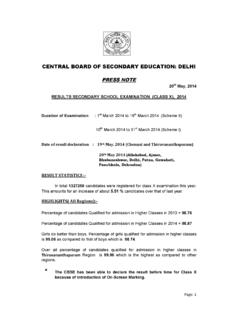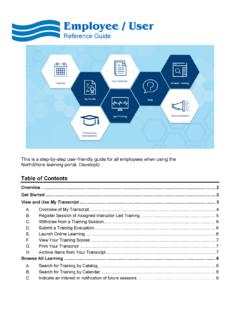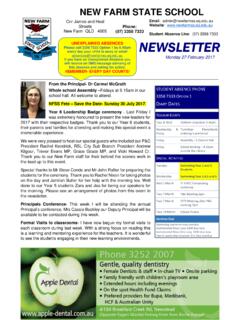Transcription of Contents
1 12 ContentsLesson Plan 1 The Digitally Literate Classroom 3 Student Resource 1 The Digitally Literate Classroom 8 Lesson Plan 2 The Digitally Literate Classroom 10 Student Resource 2 The Digitally Literate Classroom 15 Student Resource 3 The Digitally Literate Classroom 16 Lesson Plan 3 The Digitally Literate Classroom 17 Student Resource 4 The Digitally Literate Classroom 19 Student Resource 5 The Digitally Literate Classroom 20 Student Resource 6 The Digitally Literate Classroom 21 Lesson Plan 4 The Digitally Literate Classroom 22 Student Resource 7 The Digitally Literate Classroom 25 Student Resource 8 The Digitally Literate Classroom 28 Student Resource 9 The Digitally Literate Classroom 30 Student Resource 10 The Digitally Literate Classroom 33 3 Lesson Plan 1 The Digitally Literate Classroom: Reading Inanimate Alice, Episode 1 Digital Literacy Lesson Plan: Connection between story and medium in Episode 1: China, Inanimate AliceStudent Resource: Digital Literacy: Literature in a Hypermedia Mode: An interview with Marjorie Luesebrink by Thomas Swiss and Electronic Literacies by Caitlin FisherModes: Examining a Picture by Dr.
2 Martha Driver, On Gold and Silver Ages and the Elements of Hypertext by Jennifer Ley (see page 2) and Hypertext and the Art of Memory by Janine Wong and Peter StorkersonReflective ReadingMedia Type: Online, internet connection required Objectives: After completing this lesson, students will be able to: Identify and become familiar with multiple modes of representation. Critique the effects of various modes on the narrative. Give examples of explicit calls for participatory reading in Inanimate Alice. Introduction to the Lesson: Direct students to the resources listed above: Literature in a Hypermedia Mode and Electronic Literacies. Alternatively, print copies of both of the above for distribution in class.
3 Divide class into small groups of two or three and have each group read one of the resources. Have each group share two points from their readings with the class (create a list on the white board). Ask for students reactions to the points garnered. Initiate a discussion of whether students think the points are relevant only to digital literacy or apply also to print works. Teaching Strategies: 1. Begin by going over with students elements of representation: images, sound, video (streaming video, flash), animations, text, and links. Refer to the student resources listed under Modes. 2. Show students Episode 1: China, Inanimate Alice this will take approximately five Allow students to work in pairs and navigate the story on their With the whole class explore the use of sensory inputs : sound, image, and text in this Directions: Notice that the music begins on the third screen.
4 Why do you think it appears here? Turn your volume off (or turn the speakers off) and look at the third screen closely - what effect does the music have on the general tone of this screen? Does it lend a sense of urgency which otherwise is not there?4On the sixth screen the arrows which allow the reader to proceed appear on the road. Why do you think they are placed here and not close to the text as in previous screens? Screen seven is in stark contrast to the preceding scene in terms of sound. This node is almost silent. What sounds do you hear? What do you think that noise is? What might it suggest about Alice s home at the base? Screen eight enables the reader to proceed to the next part of the story relatively quickly.
5 If the reader waits, a painting evolves on the left-hand side of the screen. What do you see emerge? Do you notice a difference in the colours used for each layer of the painting that appears? 5 Midway through the narrative the reader and Alice must take photographs of all the wild flowers they can see. When you read the story for the first time, did you know you had to take the pictures or did you think it was only for Alice? How many flowers did you see? Was Alice s mum driving too quickly for you to take photographs of all four flowers? Did the music help you concentrate? When Alice writes her list of things she d rather be doing, does she sound like an eight year old? What else (hint, look at the font) helps us think she is only eight?
6 6 Examine the final two screens of the story. How do the various modes help you understand that this is the end of the story (even if the words do not say: the end )? (hint: listen to the sound, notice the jeep driving off the screen, see the darkening sky) 67 Follow Up: Critical Thinking: Give an example from Episode 1 that demonstrates Alice s comfort with technology. What other examples can you find to support this view? What message do you think the creators are trying to convey? Summarizing: What, according to the story, are some of the benefits of technology? How does the story persuade readers that this is the case? Extending: Certain critics of hypertext suggest that the reader becomes disoriented resulting in an unintelligible narrative.
7 Do you find yourself displaced when reading Episode 1 of Inanimate Alice? How do you think the creators attempt to guide the readers through the evolving narrative? Do you have your own suggestions for making the path through the narrative clearer? Explain your answers. Evaluating: Episode 1 of Inanimate Alice makes use of a variety of modes such as sound, image, text as well as demanding reader participation. In what way are these modes related? If you had to choose a single mode that adds the most to the story, which would it be? Explain your answer. Student Assessment/Reflections 1) Use the Student Reading Response handout to encourage personal reflection on the reading process.
8 Have students share their likes and dislikes of the online reading experience with partners. If the technology permits, have stu-dents post their responses on the class blog. 2) Inanimate Alice is just one example of an online fiction. Ask students to add their own choice (or more) to a class list on the class blog. 68 Student Resource 1 The Digitally Literate Classroom: Reading Inanimate Alice, Episode 1 Student Reading ReflectionNow you have finished reading Episode 1: China, Inanimate Alice. Write a short blog (or journal) entry to think about your reading experience. Be sure to answer the following:What I did (Explain how you read the story did your eyes scan each screen from left to right?
9 How did you feel about the sound, images, and words that would appear all at the same time on certain screens?)What I enjoyed (Write about what you liked most about Episode 1)What I found difficult (Write about the most difficult part of reading Episode 1)What really worked (What was the best bit about the story and why)99 Next (What will you do when it comes to reading Episode 2? How will you prepare? What tips might you share with other readers for their first digital story reading experience?)910 Lesson Plan 2 The Digitally Literate Classroom: Reading Inanimate Alice, Episode 3 Digital Literacy Lesson Plan (1 of 2): Linking homodiegetic narration and autobiography with music and sound in Episode 3: Russia, Inanimate Resource: Narratology: Narratology: A Guide to the Theory of Narrative (see on homodiegetic narrators) by Manfred Jahn Modes: How the Relationship Between Soundtrack and Image Contributes to the Meaning of the Documentary by filmmaker and journalist, Fatmir Terziu, The Sounding Image.
10 About the Relationship Between Art and Music An Art-Historical Retrospective View by Barbara John and Hypertextualizing Autobiography by Laura SullivanReading Log, Close Reading LogMedia Type: Online, internet connection required Objectives: After completing this lesson, students will be able to: Identify and become familiar with the narratological terms such as homo and heterodiegetic narrators. Identify the difference between music and sound effects. Critique the effects music on the narrative. Critique the effects of sound on the narrative. Examine the role of music/sound and image in the story. Improve their computing skills by familiarising themselves with the web browsing software.







